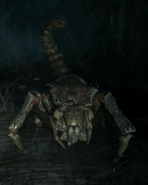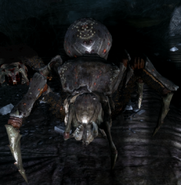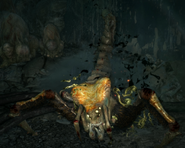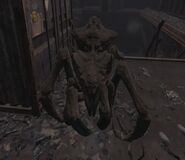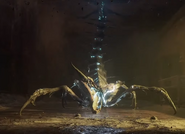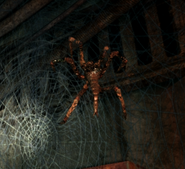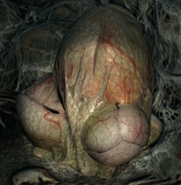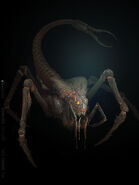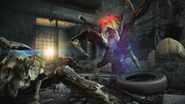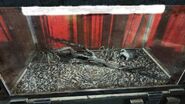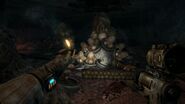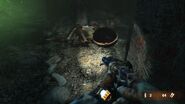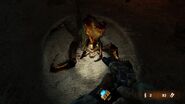The spiderbug (frequently abbreviated as spiders, Russian: Пауки) is an arachnid-like ambient creature which appears in Metro: Last Light and Metro Exodus. It combines the features of a spider and scorpion, but unlike real arachnids is deathly vulnerable to light. It is possible it is a mutated form of an species of Arachnura spider, though in real life the females have the tail.
Overview[]
Large Spiders[]
Large spiders are enemies encountered in several chapters throughout Last Light, first appearing in "Reich", but first fought in "Torchlight". All variations of spider will avoid any light sources, including Artyom's flashlight, so turn on all the available lights in your area to create safe zones in case you need to retreat. When exposed to the flashlight beam, spiders will begin to smoke, turn a reddish-black color, and often backpedal away from Artyom to attempt to break line of sight, such as by scurrying behind a pillar or around a corner. Once they are safely out of the light, they will come back to attack again. Adult spiders have a thick armored shell that is impervious to gunfire, and must be flipped onto their backs via exposure to light to kill; these can be distinguished from their weaker hatchling counterparts, that are not bulletproof, by their brown coloration. Large spiders come in several different varieties:
- Male: Spiders possessing a scorpion-like tail stinger. Their primary attacks involve a stinger jab. These appear to have been modelled to resemble Arachnura Higginsi, or scorpion tailed spider, commonly found in Australia.
- Female: Spiders with a rounded abdomen and no tail. They primarily bite and claw to attack. They seem to withstand both light and fire better than their male counterparts.
- Hatchling: These spiders are freshly emerged from their egg sacs. They are a light golden-green color, as opposed to the dull brown of their elders, and cannot withstand gunfire, unlike their adult companions. All of these found in the game are male, indicating that the small spiders that hatch with them are the females.
- Spitter: This variant is introduced in Metro Exodus, having a ranged spitting attack. Visually they look quite different to the other types of spiders, having a very jagged and even more heavily armoured appearance.
- Zap Spider: Introduced in Sam's Story DLC, this variant possesses the ability to produce electrical discharges, which it can not only use to attack prey, but also to short out any nearby electric appliances, including flashlights and motors. Any electric equipment affected by the spider's discharge won't come back on until the spider is dead. It should, thus, be a priority to kill these spiders first. They are far more durable than regular spiders, but are similarly sensitive to fire. All zap spiders appear to be male.
If they are exposed to the flashlight continuously, they will flip over. If Artyom continues to shine his flashlight at them, they will quickly die, making it unnecessary to use ammo - saying that, only a blast from a Duplet or a few Kalash rounds are enough for a kill. Artyom can also stab flipped-over spiders, although keeping the flashlight on them is arguably easier and faster. Sometimes if they are getting too close, or other spiderbugs are nearby, the flashlight trick may be useless - be ready to shoot or the quick-button event as they may pounce Artyom (usually quickly tap the action key or button), to eliminate them quickly.
Small Spiders[]
Small spiders are found hanging from webs in various locations in the game. These spiders were first seen in early gameplay trailers of the game, and pose no harm to the player character, though a few will sometimes drop down and crawl across the player character's arms and face. Their webs, though able to slow down the player character's progress, can be burned away with the lighter.
Additionally, in areas infested with spiders, small spiders can often be seen emerging in groups of 5-10 from fleshy egg sacs along the walls and floor, and emerge when approached. They are also found clustered round various dead bodies on the surface and must be removed to access the body (and any filters, ammunition, etc. it maybe carrying), indicating the spiders are carnivorous, though it's unlikely the small spiders killed any of the bodies themselves.
There is also a fish tank inside the Venice brothel that contains two small spiders, one of which will jump at Artyom when approached. This indicated that, although they are not tame, they can still be kept as pets.
These spiders seem to be immune or at least resistant to light, which might change later in their life cycle if they do grow into the adult female spiderbug; a classification based solely on proximity to larger insects.
Habitat[]
Large spiderbugs are only known to be found in deepest areas of the Metro and surrounding caves where light is very faint or non existent. Due to their weakness to light, they cannot live on the surface. Upon discovering an area that is isolated or has almost no ambient light, they will usually cover it in webbing and then start laying eggs. Therefore, transforming the area into a nest.
Little spiderbugs live everywhere across the Metro due to their apparent lack of vulnerability to light. Small spiderbugs can often be seen in ventilation shafts and even on the surface eating carrion and hunting invertebrates. Small spiderbugs however, seemingly avoid heavily populated areas of the Metro and areas of relatively intense light exposure.
In terms of geography, spiderbugs can be found all over post-apocalyptic Eurasia, from the dry deserts of the Caspian to the moist caves and tunnels of the Valley, and even as far away as the volatile coast of Vladivostok. As long as there is no light, it's a suitable habitat for their kind. Spiderbugs are also resistant to extreme amounts of radiation, as they can be found in the Vladivostok bunker, which has radiation levels comparable to those of Novosibirsk. The radiation can still cause them to mutate, however, as implied by the presence of zap spiders.
Diet[]
Spiderbugs are carnivores that hunt by ambushing their prey or confronting prey in a horde. After the prey is killed, they likely carry it away to the main nest for food storage. The exact components of its diet are unknown, however. Adult spider bugs and hatchlings likely prey on subterranean animals such as nosalis or lurkers, and are known to eat humans as well, based on the large amounts of partly-eaten corpses that can be found in their nests. Small Spiders likely sit in their webs waiting for small insects to fly in.
Reproduction[]
Like the shrimp, it's unknown how exactly the spiderbug life-cycle works. Spiders are distinctly separated between two sizes: large and small, with the small spiders arguably being infants and large spiders being adults of some variety. To support this theory, small spiders - though found around the metro and surface - are very frequently seen around large ones, and can be seen coming out of egg clutches whenever (sometimes only when) Artyom passes near them. However, at the same time, adult spiders, specifically the hatchling variant, are also seen emerging from the egg clutches.
The appearance of both types of spiders emerging from the same type of egg is most puzzling, reflecting either two separate, but co-existing, symbiotic variants of the same species of spiders, or several stages of reproduction: starting as eggs; hatch as small spiders in egg clutches; emerge; eat; make webs; move into new clutches; becoming hatchling adult spiders; mature; copulate. Small spiders themselves could even be an independent species emerging from a superficially similar mass egg-case.
Trivia[]
- Spiderbugs are encountered on the Rangers' way towards D6 in the Redux version of Metro 2033, replacing the plated nosalis.
- Various locations in Metro 2033 Redux have cobwebs, and signs of spiderbug activities, not seen in the original version.
- Do not bother wasting any ammunition on adult spiders, except when you need a little breathing room - a blast from a Duplet will stop a spider temporarily. The female spider will resist light a lot more than its male counterpart, so if it gets too close, open fire.
- Despite being extremely bullet-resistant, repeated hits will eventually punch through a spiderbug's shell.
- It's possible that there are still regular spiders inside the Metro, as some webs are of regular size (if a room is abandoned for a time, as much of the Metro is), but they are not seen.
- Artyom suggests in a note that spiderbugs were not created by the radiation when the bombs fell, but were always there, waiting in the shadows of the Metro, and only now come out as they can sense humanity is weak.
- As of the Developer Pack DLC, there is a whole level devoted to spiderbugs, called Spider Lair, where a Stalker is forced to navigate an abandoned missile silo, armed with only basic equipment and a flamethrower.
- It's unknown whether male spiders have any sort of venom in their stinger, like scorpions, or if it simply functions as a piercing/stabbing weapon.
- Spiderbugs resemble Leapers from Insomniac's Resistance franchise. They also utilize the same attack strategy of rushing the enemy in large numbers.
- The male spiderbug, especially in Metro 2033 Redux, are very visually similar to a real, common Australian spider (though much larger and able to use their tail).
Gallery[]
| Creatures of the Metro Series | |
|---|---|
| Terrestrial Animals | Bear • Biomass • Corpse Eaters • Deer • Dog • Giant Amoeba • Hare • Lurker • Nosalis • Nosalis Rhino • Pigs • Snake • Spiderbug • Slimeslug • Watcher (Watchman) • Wolf |
| Avian Animals | |
| Aquatic Animals | |
| Plant Life Forms | |
| Humanoids | |
| Supernatural Phenomena | |

